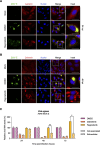The Raf kinase inhibitors Dabrafenib and Regorafenib impair Zika virus replication via distinct mechanisms
- PMID: 39023323
- PMCID: PMC11334485
- DOI: 10.1128/jvi.00618-24
The Raf kinase inhibitors Dabrafenib and Regorafenib impair Zika virus replication via distinct mechanisms
Abstract
Zika virus (ZIKV) is a re-emerging mosquito-borne flavivirus that has been associated with congenital neurological defects in fetuses born to infected mothers. At present, no vaccine or antiviral therapy is available to combat this devastating disease. Repurposing drugs that target essential host factors exploited by viruses is an attractive therapeutic approach. Here, we screened a panel of clinically approved small-molecule kinase inhibitors for their antiviral effects against a clinical isolate of ZIKV and thoroughly characterized their mechanisms of action. We found that the Raf kinase inhibitors Dabrafenib and Regorafenib potently impair the replication of ZIKV, but not that of its close relative dengue virus. Time-of-addition experiments showed that both inhibitors target ZIKV infection at post-entry steps. We found that Dabrafenib, but not Regorafenib, interfered with ZIKV genome replication by impairing both negative- and positive-strand RNA synthesis. Regorafenib, on the other hand, altered steady-state viral protein levels, viral egress, and blocked NS1 secretion. We also observed Regorafenib-induced ER fragmentation in ZIKV-infected cells, which might contribute to its antiviral effects. Because these inhibitors target different steps of the ZIKV infection cycle, their use in combination therapy may amplify their antiviral effects which could be further explored for future therapeutic strategies against ZIKV and possibly other flaviviruses.
Importance: There is an urgent need to develop effective therapeutics against re-emerging arboviruses associated with neurological disorders like Zika virus (ZIKV). We identified two FDA-approved kinase inhibitors, Dabrafenib and Regorafenib, as potent inhibitors of contemporary ZIKV strains at distinct stages of infection despite overlapping host targets. Both inhibitors reduced viral titers by ~1 to 2 log10 (~10-fold to 100-fold) with minimal cytotoxicity. Furthermore, we show that Dabrafenib inhibits ZIKV RNA replication whereas Regorafenib inhibits ZIKV translation and egress. Regorafenib has the added benefit of limiting NS1 secretion, which contributes to the pathogenesis and disease progression of several flaviviruses. Because these inhibitors affect distinct post-entry steps of ZIKV infection, their therapeutic potential may be amplified by combination therapy and likely does not require prophylactic administration. This study provides further insight into ZIKV-host interactions and has implications for the development of novel antivirals against ZIKV and possibly other flaviviruses.
Keywords: RNA virus; drug repurposing; flavivirus; host-directed antivirals; kinase inhibitors.
Conflict of interest statement
The authors declare no conflicts of interest.
Figures







Similar articles
-
The Compound SBI-0090799 Inhibits Zika Virus Infection by Blocking De Novo Formation of the Membranous Replication Compartment.J Virol. 2021 Oct 27;95(22):e0099621. doi: 10.1128/JVI.00996-21. Epub 2021 Sep 1. J Virol. 2021. PMID: 34468177 Free PMC article.
-
Antiviral activity of the FDA-approved drug candesartan cilexetil against Zika virus infection.Antiviral Res. 2019 Dec;172:104637. doi: 10.1016/j.antiviral.2019.104637. Epub 2019 Oct 25. Antiviral Res. 2019. PMID: 31669333
-
Identification of Inhibitors of ZIKV Replication.Viruses. 2020 Sep 18;12(9):1041. doi: 10.3390/v12091041. Viruses. 2020. PMID: 32961956 Free PMC article.
-
NS2B-NS3 protease inhibitors as promising compounds in the development of antivirals against Zika virus: A systematic review.J Med Virol. 2022 Feb;94(2):442-453. doi: 10.1002/jmv.27386. Epub 2021 Oct 20. J Med Virol. 2022. PMID: 34636434
-
Strategies for Zika drug discovery.Curr Opin Virol. 2019 Apr;35:19-26. doi: 10.1016/j.coviro.2019.01.005. Epub 2019 Mar 7. Curr Opin Virol. 2019. PMID: 30852345 Review.
References
MeSH terms
Substances
Grants and funding
LinkOut - more resources
Full Text Sources
Medical
Research Materials
Miscellaneous

